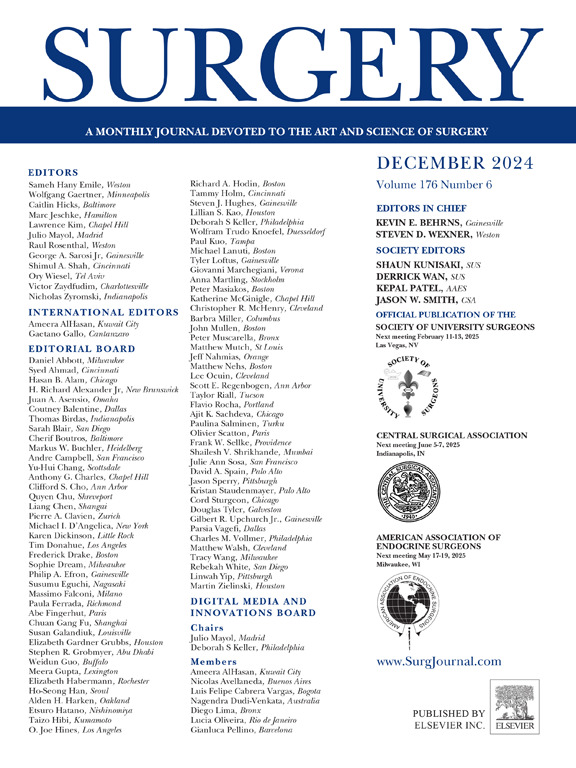Timing of parathyroidectomy after kidney transplantation: A cost-effectiveness analysis
IF 3.2
2区 医学
Q1 SURGERY
引用次数: 0
Abstract
Introduction
Parathyroidectomy is the definitive treatment for tertiary hyperparathyroidism post-kidney transplantation. However, cinacalcet-based medical management is increasingly used as an alternative. The financial consequences of each treatment remain unclear. We aimed to identify the most cost-effective strategy for managing hyperparathyroidism from the kidney transplantation recipient's perspective.
Methods
We constructed a patient-level discrete event simulation model to compare parathyroidectomy and cinacalcet-based medical management. The effects of hyperparathyroidism on allograft survival and all-cause mortality were considered in the discrete event simulation model with a time horizon of 15 years. Our base case was a 55-year-old kidney transplantation recipient with persistent hyperparathyroidism and hypercalcemia. The primary outcome was the cost-effectiveness measured by cost per quality-adjusted life years.
Results
The monthly out-of-pocket cost of cinacalcet ranged from $12 to $288, depending on insurance coverage, with a base case cost of $150. Our base case analysis showed that parathyroidectomy was the dominant treatment with lesser cost ($1,315 vs $7,147) and greater effectiveness (3.17 quality-adjusted life years and 2.92 quality-adjusted life years) than cinacalcet. One-way sensitivity analysis on the cinacalcet treatment duration showed that parathyroidectomy became more cost-effective at 9 months. Two-way sensitivity analysis on the cost of cinacalcet and the duration of treatment with cinacalcet showed that as the monthly cost of cinacalcet increases, the expense of cinacalcet-based medical management quickly exceeds the cost of parathyroidectomy.
Conclusion
Parathyroidectomy becomes more cost-effective for kidney transplantation recipients with tertiary hyperparathyroidism when they require cinacalcet-based medical management for more than 9 months. As part of shared decision-making, it is important to discuss the financial costs involved in treating tertiary hyperparathyroidism.
肾移植后甲状旁腺切除术的时机:成本效益分析
简介甲状旁腺切除术是肾移植后三级甲状旁腺功能亢进症的最终治疗方法。然而,以西那卡塞为基础的药物治疗越来越多地被用作替代治疗。每种治疗方法的经济效益尚不明确。我们的目的是从肾移植受者的角度出发,确定管理甲状旁腺功能亢进症最具成本效益的策略:我们构建了一个患者层面的离散事件模拟模型,对甲状旁腺切除术和西那卡塞药物治疗进行了比较。离散事件模拟模型考虑了甲状旁腺功能亢进症对异体移植存活率和全因死亡率的影响,时间跨度为 15 年。我们的基础病例是一名 55 岁的肾移植受者,患有持续性甲状旁腺功能亢进症和高钙血症。主要结果是以每质量调整生命年的成本来衡量成本效益:西那钙(cinacalcet)的月自付费用从 12 美元到 288 美元不等,具体取决于保险范围,基础病例费用为 150 美元。我们的基础病例分析表明,甲状旁腺切除术是最主要的治疗方法,与西那卡塞相比,成本更低(1,315 美元对 7,147 美元),疗效更高(3.17 个质量调整生命年和 2.92 个质量调整生命年)。关于西那卡塞治疗时间的单向敏感性分析表明,甲状旁腺切除术在 9 个月时更具成本效益。对西那卡塞成本和西那卡塞治疗时间的双向敏感性分析表明,随着西那卡塞每月成本的增加,基于西那卡塞的医疗管理费用很快就会超过甲状旁腺切除术的费用:结论:对于患有三级甲状旁腺功能亢进症的肾移植受者来说,当他们需要西那钙类药物治疗超过9个月时,甲状旁腺切除术的成本效益会更高。作为共同决策的一部分,讨论治疗三级甲状旁腺功能亢进症的经济成本非常重要。
本文章由计算机程序翻译,如有差异,请以英文原文为准。
求助全文
约1分钟内获得全文
求助全文
来源期刊

Surgery
医学-外科
CiteScore
5.40
自引率
5.30%
发文量
687
审稿时长
64 days
期刊介绍:
For 66 years, Surgery has published practical, authoritative information about procedures, clinical advances, and major trends shaping general surgery. Each issue features original scientific contributions and clinical reports. Peer-reviewed articles cover topics in oncology, trauma, gastrointestinal, vascular, and transplantation surgery. The journal also publishes papers from the meetings of its sponsoring societies, the Society of University Surgeons, the Central Surgical Association, and the American Association of Endocrine Surgeons.
 求助内容:
求助内容: 应助结果提醒方式:
应助结果提醒方式:


